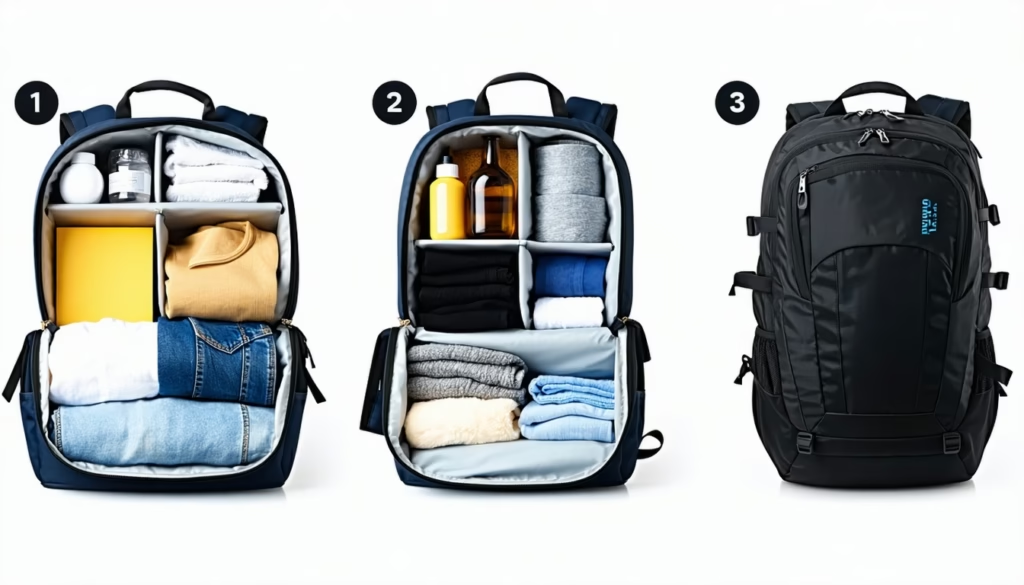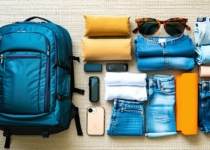The 1-2-3 Method: Minimalist Packing Strategy Explained

Ever stared at your overstuffed backpack and wondered how to squeeze in one more T-shirt? You’re not alone. Packed wrong, a backpack can feel like a stubborn puzzle. That’s where the 1-2-3 method: minimalist packing strategy explained comes in. This simple system helps you pack just what you need, no more, so every inch of your pack counts.
By the end of this ultimate guide, you’ll know how to cut clutter, stay organized, and travel lighter.
Understand The 1-2-3 Method
What Is The 1-2-3 Method?
The 1-2-3 method breaks your packing into three clear steps. First, pick one essential daily item. Next, add two multipurpose pieces. Finally, tuck in three support items. It’s that simple.
Think of it like building a capsule wardrobe for your backpack. You swap random extras for versatile staples. The result: more room and less decision fatigue.
Why It Works
This approach cuts wasted space and overpacking. You focus on items that earn their spot. It also forces you to prioritize. When every piece needs a purpose, you’ll ditch what you don’t need.
Plus, the 1-2-3 routine fits any trip length. Whether you’re on a weekender or a multiweek trek, the basic formula stays the same.
Prepare Your Gear
Before you start, gather the right gear. Having proper tools makes each step smoother.
Choose A Backpack
Pick a bag that matches your trip. A daypack works for short hikes while a 40L travel backpack suits multiweek travel. Look for padded straps, a ventilated back panel, and multiple compartments.
Gather Packing Cubes
Packing cubes keep your layers organized. These little bags fit inside your pack without adding bulk. If you want more details, check out our guide to using packing cubes for ultimate luggage organization.
Add Compression Bags
For bulky items use compression bags. They squeeze out excess air so you can pack more. Consider a set of flat or vacuum options if you need even more shrink power.
Sort Essential Items
This step narrows down what really needs to make the cut.
Create An Item List
Start by listing out everything you think you’ll need. Clothing, toiletries, gadgets, and accessories all make the list. Seeing your items on paper prevents duplicates.
Group By Category
Next, group similar items together. Shirts go in one pile, underwear in another. This visual grouping speeds up decision making.
Prioritize Must-Haves
Now apply the 1-2-3 concept. Pick one essential daily layer like a pair of pants or a dress. Choose two multiuse pieces such as a shirt that works for day and night. Then select three support items—maybe a scarf, a hat, and a lightweight jacket.
Need more packing inspiration? Check out these genius packing tricks.
Layer Packed Clothing
Layering keeps you ready for shifting weather and saves space.
Base Layer Details
Your base layer touches skin. Think of lightweight, moisture-wicking shirts or leggings. They dry fast and double as pajamas if needed.
Mid Layer Tips
The mid layer adds warmth. A merino wool shirt or thin fleece works well. These pieces also pull double duty as travel outfits on cooler evenings.
If you want deeper insights into efficient layering, see our step-by-step guide to layering clothes efficiently when packing.
Outer Layer Strategy
Your outer layer handles wind or rain. Pick a packable rain jacket or light windbreaker. It’s one piece that covers multiple weather scenarios.
Compress And Secure
Once you’ve layered, it’s time to compress and seal.
Use Compression Bags
Insert your layered cubes into compression bags. Press out air by rolling or squeezing. Then zip them tight. You’ll free up enough space to fit extra socks or a guidebook.
Roll Versus Fold
Rolling saves more room and prevents wrinkles. For structured items like pants, fold once in half then roll. That keeps creases minimal.
Seal And Test
After compression, seal each bag. Then give a gentle shake. If items shift too much, swap them around until everything sits snug.
Adapt To Backpack
Not all packs behave the same way. Tweak the method to your bag’s design.
Match Pack To Trip
Your approach changes with trip type. On a hike choose gear-specific items like trekking poles. For city travel lean into multiuse layers.
For camping gear tweaks, see these space-saving hacks for hiking backpacks and gear.
Balance Weight
Keep heavier items centered and close to your back. Distribute weight evenly side to side. Stow lighter layers toward the pack’s edges.
Access Quick Items
Use external pockets for quick grabs like snacks, sunglasses, and a map. You don’t need to unpack just to get a candy bar.
Avoid Common Mistakes
Here’s what tends to go wrong and how to sidestep each hiccup.
| Mistake | Why It Happens | How To Fix |
|---|---|---|
| Overpacking | Emotional urge to bring “just in case” | Apply the 1-2-3 ratio strictly |
| Ignoring Weight Limits | Eyeing volume, not mass | Weigh bag at home before you zip up |
| Skipping Accessibility | Packing everything inside | Store daily items in outer pockets |
| No Advance Planning | Packing at the last minute | Prep list and gear a day earlier |
Try Advanced Tricks
Once you’ve mastered the basics, level up with these hacks.
Wear Bulky Pieces
Put on your heaviest shoes and jacket when you travel. That frees up bulk inside your pack while keeping you warm.
Use Multiuse Gear
Grab items that serve double duty. A bandana can be a headband, pot scrubber, or sweat rag. A buff scarf works as a neck warmer or sleep mask.
DIY Packing Tools
Make simple dividers with zip bags or cut-down cardboard. You can also stitch small pockets onto the pack lid for cables.
For more on handling tech gear, see our guide to tech gadget packing.
FAQs
How Does The 1-2-3 Method Fit Various Trips?
It scales up or down easily. For a weekend trip, apply one 1-2-3 set. For longer travel, stack multiple sets of essentials.
Can I Use It For Carry-On Only Trips?
Yes absolutely. The formula is perfect for carry-on only packing. For more tips, check out these carry-on pack hacks.
Do I Need Packing Cubes To Follow The Method?
Cubes help with organization but aren’t required. You can sort layers by type in any divider or zip bag.
How Do I Adjust For Bulkier Clothes?
Use compression bags or wear bulk items on the plane. Also choose wrinkle-resistant fabrics that pack down. Read more on packing sweaters and jackets via our bulkier clothes tips.
Is Compression Safe For Delicate Fabrics?
Sort delicate items separately and use gentle compression bags. Avoid vacuum options with fragile garments.
How Does It Work For Camping Gear?
Treat sleeping bags or tents as support items. You might swap the count to 1-1-1 for very bulky camping pieces.
Conclusion
Packing light doesn’t have to feel like rocket science. The 1-2-3 method: minimalist packing strategy explained gives you a simple blueprint. You gather the right gear, sort smartly, and optimize every cubic inch.
Try this routine on your next trip and notice how much easier pulling on your pack feels. Stick to versatile pieces and use these steps as your go-to checklist. Safe travels, and may your backpack carry more memories than mistakes.


